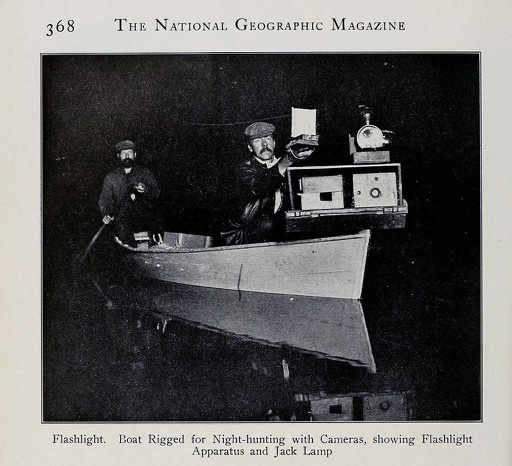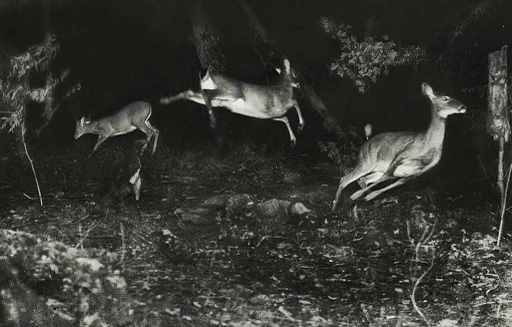
George Shiras III was a pioneer in wildlife and night photography, renowned for his innovative techniques in capturing animals in their natural habitats. Born in 1859, Shiras combined his passion for nature with his interest in photography. He is best known for his early work in photographing wildlife at night, particularly in the forests and lakes of the Upper Peninsula of Michigan, using flash photography.

Some key points about Shiras include:
- Pioneering Flash Photography: Shiras was among the first to use flash photography to capture nocturnal wildlife. He utilized a technique called “camera trapping,” where he rigged cameras to be triggered by the movement of animals. This method allowed him to photograph elusive creatures in their natural behaviors without human interference.
- Contributions to National Geographic: His work gained significant attention when he contributed to National Geographic Magazine. He was called “Grandfather Flash—the Pioneer of Wildlife Photography“. In 1906, the magazine published his photos, which were groundbreaking for their time. Shiras’s images helped readers visualize the beauty and mystery of the natural world, particularly at night.
- Legacy in Conservation: Shiras was not just a photographer; he was also a conservationist. His images brought public awareness to wildlife and the need to preserve natural habitats. His work inspired early wildlife conservation efforts and continues to be regarded as a crucial element in the history of nature photography.
- Legal Career and Political Involvement: Shiras was also a lawyer and politician. He served in the U.S. House of Representatives from 1903 to 1905, where he advocated for environmental issues. His political efforts helped in shaping early conservation policies in the United States.
Contest Guidelines:
- Theme: Nighttime Wildlife of the Upper Peninsula. All entries must capture wildlife at night, reflecting the spirit of George Shiras III’s pioneering work.
- Eligibility: Open to all residents of the Upper Peninsula, regardless of age or photography skill level.
- Submission Deadline: All submissions must be received by midnight on November 30th, 2024.
Winners will be notified via email and will be announced on our website and social media channels. The announcement will be made no later than Tuesday, December 3rd by noon.
Photo Requirements:
- Originality: Photos must be original, taken by the person entering the contest. Plagiarized or copied images will be disqualified.
- Nighttime: Photos must be taken during nighttime hours (after sunset and before sunrise).
- File Format: Submissions must be high-resolution JPEG or PNG files, with a size between 6MB and 25MB, and a minimum resolution of 3000 x 2400 pixels. No other file formats will be accepted.
- Editing: Basic photo editing (cropping or color correction) is allowed, but excessive manipulation (e.g., adding or removing elements) is not allowed.
Submission Process:
- Limit of one photo per entrant (JPEG or PNG formats only).
- Each submission must include the entrant’s name, contact information, the date and location of the photo, and a brief description (~100 words) of the experience or technique used to capture the image.
- Photos must be submitted via the form posted at shirasplanetarium.org/photography-contest-entry.
Judging Criteria:
- Creativity: How well the photo captures the essence of nighttime wildlife.
- Technical Skill: Use of lighting, focus, composition, and clarity.
- Originality: Unique perspectives or methods of capturing the wildlife.
- Connection to Theme: How the photo reflects the spirit of George Shiras III’s work.
Prizes:
- First Place: $250 cash and a certificate for an hour long mentoring session with Daniele Carol Photography
- Second Place: $150 cash
- Third Place: $50 cash
- Honorable Mentions (2): $25 cash
Judging Process:
- A panel composed of MSHS Photography Club students, teachers, and community members will score each submission based on the judging criteria.
- The judges will utilize the following rubric to evaluate the photos:
| Criteria | Points | Description |
| Creativity | 1-10 | -Unique perspective, original approach, or an unexpected depiction of nighttime wildlife. -Use of lighting, shadows, and angles to create an engaging image. |
| Technical Skill | 1-10 | -Clarity, focus, and sharpness of the subject. -Appropriate exposure and use of lighting in a nighttime setting. -Effective composition and framing of the shot. |
| Originality | 1-10 | -Depiction of wildlife in an unusual or rarely seen way. -The photographer’s personal style and vision are evident in the photo. -The photo is distinct from common or overly staged wildlife images. |
| Connection to Theme | 1-10 | -How well the photo captures the essence of nighttime wildlife. -Does it reflect the pioneering spirit of George Shiras III’s work? -Does the image evoke the natural and mysterious elements of nighttime wildlife? |
- Judges will shortlist entries, and a final panel discussion will determine the top three winners and two honorable mentions.
- Judges rate each photo in all four categories, assigning a score between 1 and 10 for each.
- Higher scores indicate stronger alignment with the criteria (e.g., a 10 in Creativity signifies an exceptionally creative photo).
- Total scores will be calculated out of a maximum of 40 points.
Additional Considerations:
- Permissions: Entrants must secure permission if the photo includes private property or identifiable individuals.
- Photo Rights: By entering, participants grant Shiras Planetarium non-exclusive rights to use their photos for educational and promotional purposes, with proper credit to the photographer.
- Exhibition: An exhibition will be held after the contest is complete. By entering, participants agree to allow their photos to be showcased.
- Safety: Participants must prioritize their safety and that of the wildlife while taking photos at night (e.g., avoid close encounters with dangerous animals and take precautions in low-visibility conditions).
Thank you to our contest sponsors!
The Shiras Institute
The Shiras Planetarium
Daniele Carol Photography
MSHS Photography Club





Learn More About George Shiras III
George Shiras authored two volumes of Hunting Wild Life with Camera and Flashlight: A Record of Sixty-Five Years’ Visits to the Woods and Waters of North America. Both Volume I and Volume II are available to view.
For more information about George Shiras and his work with night photography, check out this article written by Mikel B Classen.
For more insight into George Shiras III and the birth of wildlife photography, be sure to read Camera Hunter, by James H. McCommons. You can read more about the creation of this book and McCommons work related to Shiras.
The Aptitude Outdoors Podcast featured the work of George Shiras III in a video podcast.
Discovering did an episode featuring George Shiras III.